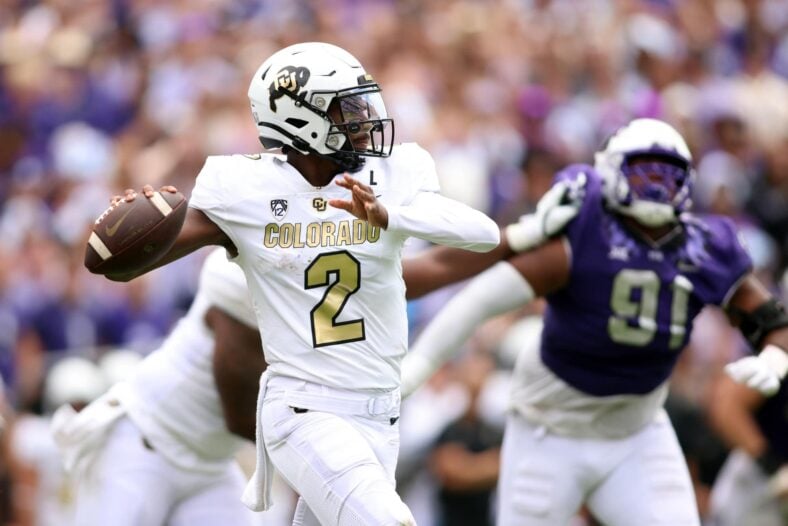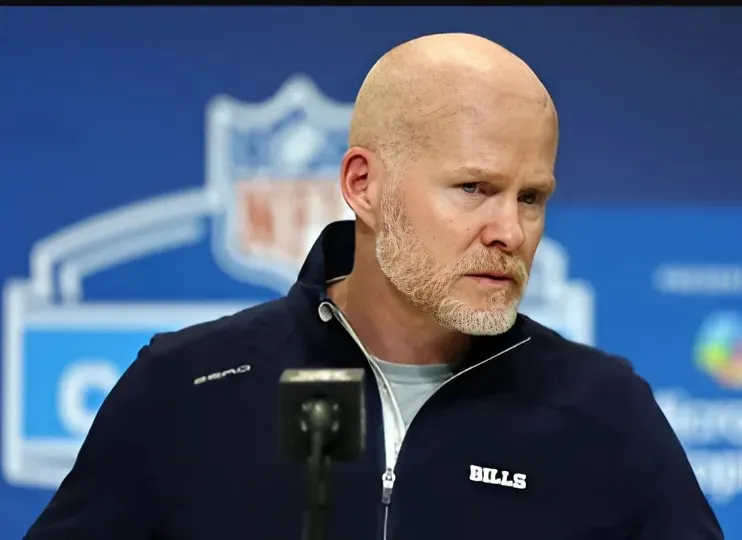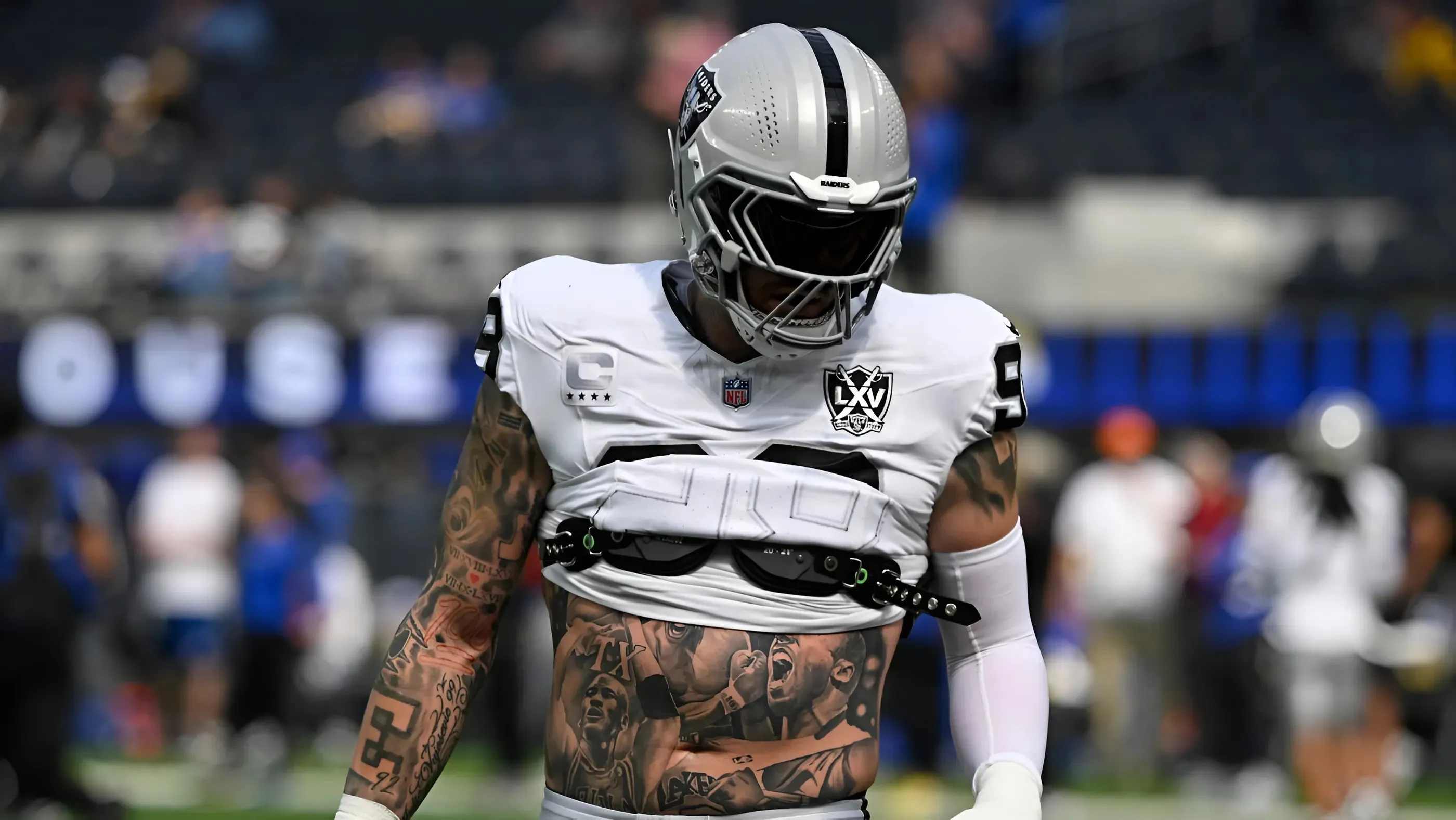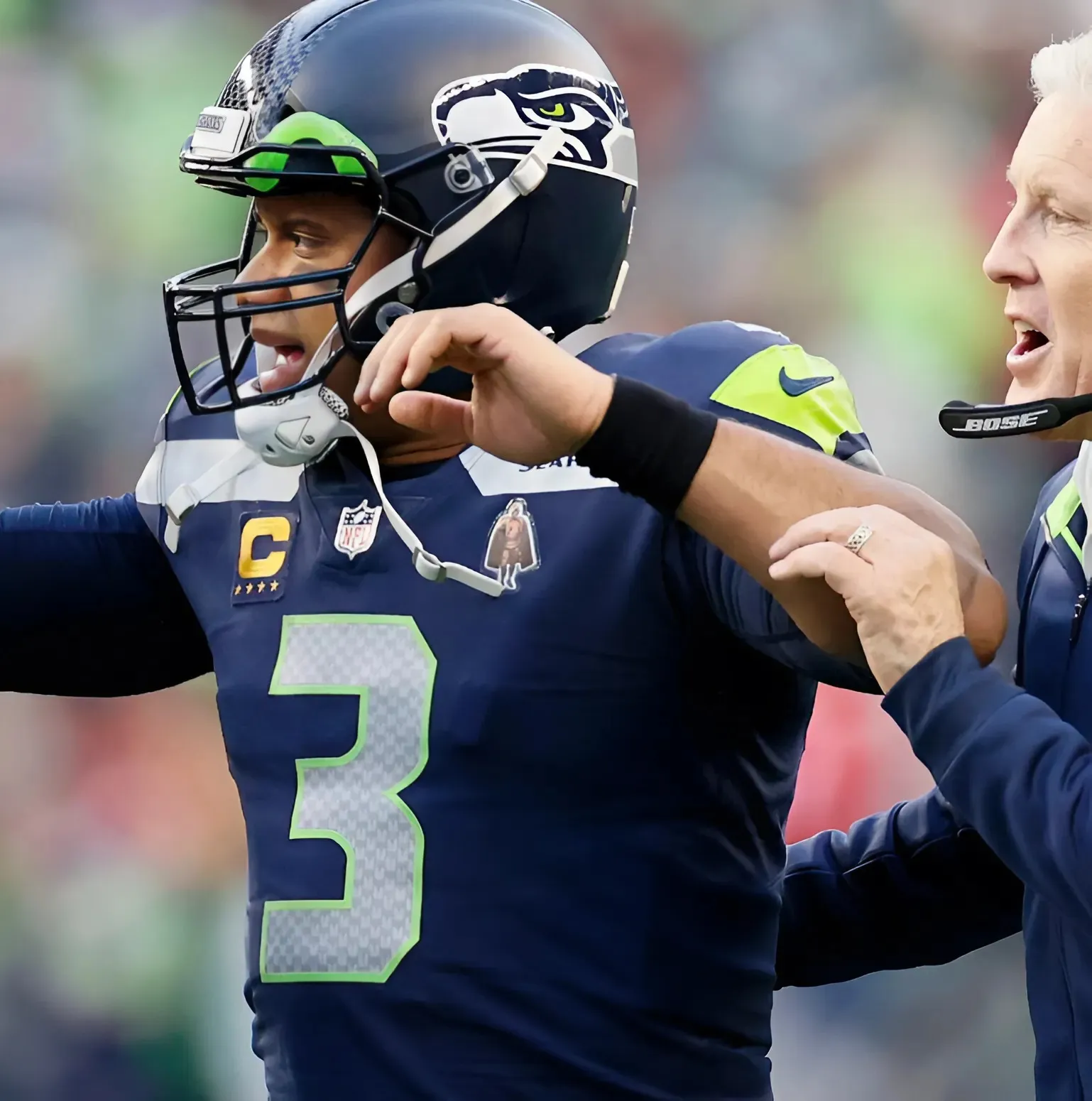With the 2025 NFL Draft now less than two weeks away, there are a plethora of intriguing storylines circulating the media sphere. One of the more polarizing prospects in the entire class is Colorado quarterback Shedeur Sanders, who just so happened to make a visit to the south side this week. It’s no secret that the Pittsburgh Steelers are actively perusing all available options at the sports most important positionvvxz, whether that’s a stopgap solution in Aaron Rodgers, or any of the eligible passers that this cycle has to offer.

It wasn’t long ago that Sanders was getting hyped up as a potential number one overall selection, but that buzz has faded since the NFL Combine. Even if the league is lower on him as a player than what the general public previously perceived, all it takes is one organization to believe in him. Could the Steelers be that team? Will they even get the opportunity to select him? We’ll see!
While awaiting those answers, all we can do is dive back into the tape and figure out if his skill set is worth taking a swing on in round one. But before getting too far into the weeds, it’s important to set the stage by painting the picture of the environment that Sanders was operating within last year. After watching over a half dozen games, there’s so much necessary context that goes into his evaluation. In an effort to avoid further burying the lede, I’ll be blunt.
HOW GOOD IS SHEDEUR SANDERS?
The Buffaloes offense was a shotgun-based spread attack using a roster that was built for high-octane 7-on-7 football tournaments but they completely forgot that the offensive line position is sort of important on Saturdays. The interior offensive line was incapable of picking up stunts on a consistent basis and neither of their tackles could hold up in pass protection, which was further exacerbated by their insistence on playing with open edges. Their third down back is often lost in pass protection and their tight end isn’t a functional in-line blocker. The team threw the ball at an incredibly high rate because they couldn’t run the ball efficiently (3.9 yards per carry).
Because of their roster construction, they were left running a ton of 10 personnel because their wide receivers are their best players, but you’d be surprised by how often multiple eligibles are running in the same vacinity. Their offensive playbook is a very small catalog on concepts, which again could be linked back to their limitations up front. It’s heavily reliant on RPO’s and quick game throws underneath with an absurd amount of screens on what felt like every series: 21% of Sanders throws on the season fell in this category. That is not a typo. They rarely went under center, there’s very little play action or moving the launch point for the quarterback and the lack of motion is rather archaic, resembling the early-2000s Colts offense under Peyton Manning. Now to the good stuff…
The number one thing that stands out with Sanders is his unflappable toughness. You never have to worry about this dude getting gun shy. He’s proven time and time again that he’s willing to hang in the pocket with a defender running full speed ahead at him to attempt to deliver a knockout blow. He never wavered, even when those hits graduated from physical football plays to to blatant cheap shots like in the Kansas Game. This was on display all too often because of how porous the pass protection was for the entirety of his tenure at Colorado. Opponents didn’t need to blitz in order to get pressure on him but Sanders relished the opportunity to make defensive coordinators pay for those decisions with deep shots down the field.
— Derrick (@Steelers_DB) April 11, 2025Shedeur with a drop in the bucket, hitting the slot fade on the shock concept vs. Cover 0.
Excellent touch away from leverage with a guy in his face. pic.twitter.com/RQdBWIATG9
As previously mentioned, this wasn’t the most robust playbook by any stretch of the imagination but Sanders showed the necessary football acumen to execute pro style concepts in the dropback passing game. There were multiple examples of him cycling through his progressions on Y-cross to find the backside dig all within the rhythm of the play from within the pocket. Sanders loved to work this hi-lo concept that Kyle Shanahan refers to as “bow“, which in essence is just an underneath arrow route designed to draw attention of the hook defender while a receivers wraps in behind him on a basic route. Colorado might have run “hank” or curl-flat more than any team since the Todd Haley-era Steelers but he consistently read the play correctly and got the ball to the open man. When things weren’t there, he regularly found the check down. Hey, you can’t go broke taking a profit.
Another feather in his cap from a processing standpoint is that he reads coverages and processes information fairly well post-snap and there were some really high-level flashes of him beating exotic looks. These 2-to-1 or 1-to-2 coverage rotations are all the rage right now in the league because defensive masterminds are trying to make quarterbacks more work post-snap to give their fronts an extra beat to get in the backfield. Whether it was beating a tampa-2 rotation with a hole shot down the sideline or something as simple as “pick a side” quick-game reads that relied on him making quick decisions based on the roll of the safeties, this was a plus. One more important note on Sanders from an above the neck standpoint: he rarely was confused, baited into ill-advised tosses or putting the ball in harms way. Per PFF’s charting, he finished last season with a staggeringly-low 1.3% turnover-worthy play rate.
The other selling point to Sanders game is the sharpshooter accuracy to the short and intermediate areas of the field. When his base is on point, there’s a level of precision to his game that you really appreciate because not only does the ball hardly ever touch the ground, it’s hitting receivers in stride without forcing them to break their momentum. His release isn’t the quickest but his throwing motion is very repeatable. Much of Sanders intrigue relies on his comfortability operating in the middle of the field, in part because he’ll flex the capacity to move zone defenders out of position with his eyes and shoulders. In-breakers (slants/digs/crossers) are his specialty and it’s a real shame that his college ecosystem didn’t embrace this element of his game even more.
When it comes to the long ball, Sanders is always going to give guys a chance down the field. He throws with plenty of arc. When he’s predetermined that he wants to take a shot down the sideline and enters his throwing motion promptly after hitting his back foot, he can deliver some dimes outside the numbers and away from defender leverage. Now to the concerns…
While he deserves credit for cutting down on the sacks in 2024, Sanders still has some extremely painful pocket habits that are going to be difficult to break at the next level. He’s a relentless drifter that likes to set deep in the pocket, often at nine yards or so, and continue moving backwards until he decides to throw the football.

There are multiple issues with this style of playing worth digging into. It’s true that the he was often operating in chaos but it’s also an undeniable fact that he made life very difficult on his tackles with the depth of his drop. How much of that is just scar tissue from him simply not trusting the offense line and feeling like he had to go try to be superman to bail them out? That’s something that every NFL team is trying to figure out.
As the season went on and the hits starting taking their toll, it seemed like his internal clock had been sped up and he reverted back to bailing on clean pockets to go and try to create out of structure. He’s can occasionally escape a defender but lacks the ideal quick twitch movements to make guys miss regularly. Even on plays where he was able to exit the pocket, there were plenty of examples of him being hawked down from behind by defenders. With that being said, Sanders does a good job keeping his eyes up to scan for his teammates and is generally accurate on the run while moving to his right. However, his accuracy dips when he’s falling off platform, particularly when throwing to his left. It’s difficult to see him making a living as an off-script creator in the NFL.
Along with only average overall athleticism, Sanders overall arm talent falls in that same middling category. He struggles to drive the football on a line and it’s an issue in every single game you watch. Out-breakers will get hung inside for cornerbacks to interfere with, long-range connections sputter out forcing receivers to work back to the ball and certain completions on tape seem destined to turn into worse outcome in the pros. Whenever you’re watching film on the top passers in any given draft class, you expect to see some throws where the quarterback is beating good coverage with their arm strength. Unfortunately, those are very few and far in between on Sanders film. Particularly when there’s pressure that compromises his base, he has real issues generating enough velocity to beat tight windows.
The final area of improvement for Sanders will likely be the deciding factor in whether or not he succeeds in the NFL and it starts with anticipation. Because of how often he’s aimlessly drifting in the backfield, his footwork can take him out of a ready to throw state and when you factor in an elongated throwing motion, he’s not the anticipatory thrower that he needs to be to compensate for his lack of drive velocity. Not to mention that the depth of his drop almost always lengthens the throwing distance between him and his target, making it unnecessarily difficult for him. There are varying opinions on whether patting the ball before its release actually matters but it’s fair to acknowledge that Sanders did have 20 passes batted down at the line of scrimmage over the past two seasons.
WHERE WILL SHEDEUR SANDERS BE DRAFTED?
The only reason that there’s even a slim chance that the Steelers could have a chance at drafting Sanders in the first round is because NFL teams obsess over tools even sometimes at the expense of production. There’s no way around the fact that his traits are going to be average at best when comparing them against other starting-caliber signal callers at the next level. That doesn’t mean he can’t still be successful, it just trims down the margin for error.
While I don’t think it’s an apt comparison on it’s own, Sanders would be wise to try and mimic Cincinnati Bengals quarterback Joe Burrow’s path to stardom. The footwork has to be precise down to the drop and subsequent hitch up in the pocket. Most importantly, the ball has to be out before the break on every single rep, regardless of target location. Sanders shows real promise as a middle of the field touch thrower but those windows that used to be five yards are going to be shrunk down immensely in the pros. The “see it, throw it” mentality must be a thing of the past. In order for him to maximize his skill set, he has to be willing to adapt his play style to fit a timing based offense.

What are some realistic comparisons for Sanders, you might ask? Teddy Bridgewater, the Minnesota Vikings number 32 overall selection in the 2014 NFL Draft, feels like an appropriate correlation and realistic outcome. The Louisville product had nearly identical measurables: standing 6-foot-2 while weighing in at 212 pounds with hands on the smaller side. If you go back and read some of the scouting reports on him coming out of college, the strengths and weaknesses are eerily similar in a number of different categories. We’ll never truly know what he could have become due to the devastating injury that he suffered early in his NFL career.
From a physical profile and intangible standpoint, there are a lot of similarities. Bridgewater was a bit more polished from his experience coming up in an NFL system but I believe that Sanders has a slightly stronger arm entering the NFL. Of course, with time on task and development, Sanders could certainly exceed that threshold but we’re talking the relatively “average” outcome here.
The encouraging part of Sanders evaluation, beyond the toughness, processing and accuracy, is that there are examples of him doing the things listed in the above paragraph. If you go back and watch the Colorado State film from this past season, there are translatable reps galore. He can step up in the pocket and throw with anticipation. For a myriad of reasons, that was never consistent in college. Recently, Dane Brugler of The Athletic recalled a conversation he had with Colts general manager Chris Ballard, saying that if a player did it once, he can do it again- you just have to coach it out of him. If a team falls in line with that ideology, it will be easier to get on board with a quarterback like this.
And while it’s unrealistic to assume he can work his way into a Josh Allen-like bazooka overnight, it’s not unfathomable to think that Sanders can make improvements in his game from a velocity standpoint. There’s some inefficiencies in his lower half that can be tweaked. Right now, Sanders is a really linear thrower that doesn’t generate a lot of torque from his hips and it looks like he’s lifting upwards instead of rotating through. Legendary trainer Tom House refers to the biomechanics of throwing as kinematic sequencing. As you see, there’s more to it than simply how strong ones arm is.
His situation in college makes for a truly miserable evaluation but that’s what NFL teams are left with. For me, Sanders is QB2 with a second-round grade and someone that I believe could develop into a solid starting quarterback. I would be leery about trading up in the first round to acquire him and I also find it difficult to believe that he would be one of my highest rated players by the time that the Steelers get on the clock at pick 21. Even if round one is a bit rich for my blood, it would be an understandable conclusion for them to come to given how humongous the current need is and how pertinent this position is to long-term success in the league.
Sanders has the vibrant personality that head coach Mike Tomlin typically gravitates towards and that pairing alone makes me wonder about the possibilities. The toughness, poise and confidence are things that are unspoken prerequisites for this position that you can’t teach and he already possesses in spades. Even though I do have concerns about the upside, the idea of this ultra-competitive coaches kid with a chip on his shoulder landing in the steel city does at least pique my interest… assuming that Sanders is willing to buy into the role of rhythmic disruptor.



